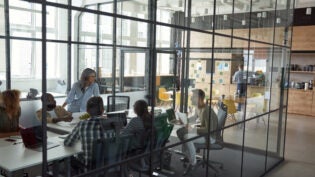Maximizing Staff Engagement and Productivity at Meetings
By: SmallBizClub

At one point or another, we’ve all had the pleasure of attending a painfully unproductive meeting. Most businesses have far too many meetings and we’re just not very effective at them. We may be ‘at work’ but we’re usually not achieving very much at these gatherings of weary-eyed mortals. The truth is, many meetings unnecessary and tedious, which likely contributes to the fact that around one third of them are an utter waste of time.
Consequently, we’re left with very little time to actually get any work done—but hey, we’ve sure talked a lot about what we need to do. Super.
The solution, however, is pretty straightforward, though seemingly a well-kept secret: have less meetings, keep them as small as possible, make them shorter, appoint a clear decision maker, and stick to a strict agenda and timeframe. And to ensure everyone in attendance is actually engaged, try to make these essential meetings enjoyable by implementing four simply tactics:
1. Get walking
Steve Jobs was a big fan of the walking meeting. It’s an incredibly effective way to boost creativity and increase alertness. After all, it’s pretty difficult to doze off when you’re on your feet. We sit on our butts for such a large part of the working week, which is not only damaging to our physical health, it’s killing our cognitive functions and emotional wellbeing.
Why not use meetings as an opportunity to stretch the legs, energize yourself and your colleagues, and generate the flow of creativity to achieve your business goals. What’s more, it’s a great way to connect with your team and break down the barriers of communication. You’ll all perform better, achieve more and feel significantly happier inside.
2. Avoid early-morning starts
It can be tough striking a healthy balance between work life and home life, so it’s best to schedule meetings at a time of day when the required attendees are less likely to be late due to commuting delays or personal commitments. Stressed workers are not going to be engaged. And if they turn up late to a meeting, they’ll feel embarrassed and frazzled.
Lateness is also inconvenient for everyone else in attendance and can be damaging to working relations. To avoid this scenario, schedule meetings late morning or early afternoon to ensure everyone is on time, relaxed and focused. There’s little benefit to having an important meeting if essential attendees are absent or too stressed to concentrate.
3. Provide refreshments
Donuts? Cakes? Sandwiches? Chocolate? Soda? No, you’ll all end up on a short-lived sugar high and become drowsy when the meeting finishes. Booze? Could be interesting…. But no. Avoid heavy food, sugar-laden snacks and mind-altering libations. Instead, opt for healthy, nutritious refreshments that encourage better habits, increase alertness and facilitate cognitive functions. Try the following:
- Fresh fruit, especially bananas
- Popcorn (a personal favorite)
- Nuts, seeds and dried fruit
- Slow-release energy bars, e.g. flapjacks or granola bars
- Rice cakes
- Whole wheat crackers
- Pretzels
- Raw vegetables with humus dip or peanut butter
- Wasabi peas
- Fruit tea and water
While you may view this suggestion as an unnecessary expense, the potential benefits are certain to increase motivation, promote better teamwork and enhance productivity, all of which will improve your bottom line. When we’re sufficiently hydrated and nutritiously satisfied, we’re simply more effective. And your meetings might even be, dare I say it… fun.
4. Keep it positive
Positive reinforcement isn’t just an effective way to train our canine companions. Injecting positivity into meetings can significantly lift everyone’s mood, improve the way our brains work and encourage better engagement. If you simply focus on the negatives or spend the entirety of your meetings berating people, you’ll simply bring the mood down and leave your team feeling demotivated and resentful.
According to Dr Daniel Goleman, New York Times bestselling author and world-renowned researcher in emotional and social intelligence, “When the team leader is in a positive mood, the group picks up on that feeling and their performance is enhanced. If the leader is in a negative mood, the group catches it and their performance suffers.” Remember this at your next meeting – be aware of your emotions, set the right mood and inspire positivity throughout your team.
 Author: Rachel Craig is the senior content writer and editor for 1st Formations Limited, the UK’s leading company formation agency. She provides small business advice and technical guidance on UK company registration, statutory compliance and workplace productivity.
Author: Rachel Craig is the senior content writer and editor for 1st Formations Limited, the UK’s leading company formation agency. She provides small business advice and technical guidance on UK company registration, statutory compliance and workplace productivity.
5024 Views












